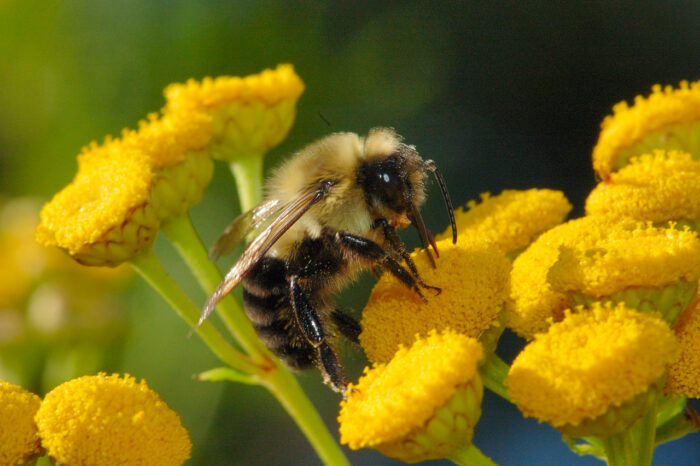Take a deep breath. Close your eyes for a moment, and imagine you’re shrinking to the size of a bee. Open your eyes. You now have five of them: two big ones on each side of your head, and three smaller ones at the centre of your head, above your antennae. You’re the size of a thumbnail, maybe a little bit bigger. You’ve grown four wings on your back, and an extra leg has sprung on each side of your body, above your hips.
You’re a wild bee. Not the domesticated honey bee that first comes to mind; there are more than 20,000 species of wild bees in the world. So pick a wild one. You might be a fuzzy bumblebee or a carpenter bee with a shiny black abdomen and beautiful, blue tinted wings. Wild bees are incredibly important – a study conducted in the UK has shown that honeybees provided at most one third of pollination services, with the rest being supplied by wild pollinators.
You fly out the window and look around. You’re much more aware of the little pockets of nature around you than you normally would be as a human. You notice the trees, and above all the flowers. They’re colourful, and their delicious scents are calling you. You’re looking for pollen or maybe nectar, a sugary substance found in flowers that you like to feed on. You like to eat both – nectar gives you energy, and pollen provides other nutrients such as protein. As you visit a flower to feast on its nectar, pollen grains attach to your body. As you move around, some of these pollen grains get dropped on other flowers. Through this process, known as pollination, these flowers will be able to reproduce and turn into fruits.
Thanks to you, as well as other pollinators such as butterflies, hummingbirds and bats, humans have been enjoying foods as diverse as tomatoes, blueberries, almonds, avocados and cherries for millennia. Without you, they would never have discovered these pleasures. They would not have coffee, nor chocolate. One in every three mouthfuls humans eat depends on pollinators such as bees.
Humans don’t fully understand you yet, but studies about your kind are starting to emerge. Some scientists have found that bees can demonstrate emotions resembling playfulness and optimism but also frustration and fear. Some suggest bees can even recognise different human faces, experience PTSD-like symptoms, and process long-term memories.
Humans don’t understand you, but their activities are hurting you. They spray their fields with harmful chemicals to kill so-called “pests”. These chemicals hurt you. They can even kill you. Because of industrial agriculture, the monocrop fields they are growing with increasing intensity have replaced the thriving ecosystems you used to call home. They are cutting down entire forests to build cities, or to grow even more of the same few plants. Monotonous fields as far as the eye can see. And so wild bee populations are decreasing.
Research has shown that between 25% and 68% of wild bee species in Europe are endangered, depending on the region. And less pollinator diversity results in fewer wild plants, which many other species feed on, from squirrels to sparrows. This can have a ripple effect on entire ecosystems. Goal 15, Life on Land, aims to protect and restore terrestrial ecosystems, and to reverse land degradation and biodiversity loss. None of this can be achieved without diverse and healthy pollinator populations.
Another deep breath. Back to your human self. So what can you do to help the bees?
- Create pollinator-friendly habitats by planting a diverse range of native wildflowers in your garden or on your windowsill
- If possible, support small-scale, sustainable farmers by buying in season, local, organic food
- If you find a bee that seems to be struggling, try gently relocating it near a bee-friendly flower. If there are no flowers around you can offer a few drops of water mixed with white sugar on a teaspoon
And you can share this with someone around you to help more humans understand the importance of protecting our precious bees. Happy World Bee Day!
Author: Tiphaine Marie Pittet, Environmental communicator and host of biodiversity podcast Why We Care
Sources:
https://www.fibl.org/fileadmin/documents/shop/1645-wild-bees.pdf
https://www.theguardian.com/environment/2023/apr/02/bees-intelligence-minds-pollination
https://www.wwf.org.uk/learn/fascinating-facts/bees
https://www.youtube.com/watch?v=VSYgDssQUtA&ab_channel=DWPlanetA




